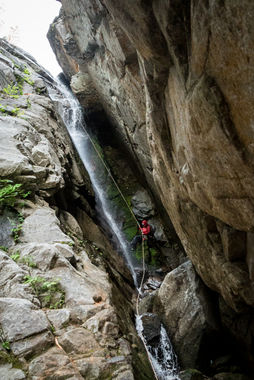Malachite Canyon
| Rating: | |||||||||||||||||||||||||||||||
|---|---|---|---|---|---|---|---|---|---|---|---|---|---|---|---|---|---|---|---|---|---|---|---|---|---|---|---|---|---|---|---|
| | Difficulty:3B (v3a2) Raps:11-13, max ↨200ft
Red Tape:No permit required Shuttle:None Vehicle:Passenger Rock type:crumbly granite | ||||||||||||||||||||||||||||||
| Location: | |||||||||||||||||||||||||||||||
| Condition Reports: | 4 Aug 2018
"The first descent took us 10.5 hours. Likely a 3.5 rating canyon - more stars if the approach wasnt so difficult. The approach took us 4 hours but we |
||||||||||||||||||||||||||||||
| Best season: | June-Sept
|
||||||||||||||||||||||||||||||
| Regions: | |||||||||||||||||||||||||||||||
Introduction[edit]
Malachite is a fun canyon with unique geology. The canyon itself is a steep v-slot with slanted walls and flakey granite. The many rocks and boulders that have fallen from the canyon walls provide many options for cairn/deadman anchors that can be used in low flow. The canyon features rapid fire rappels and beautiful views of the valley below, dropping 1400' in a little under half a mile.
Approach[edit]
Follow the tracks until you reach the bottom of the first waterfall -- this will be fairly straightforward consisting of easy forest and stream walking. Enjoy the thimble berries and prepare for the slog up. Proceed to bushwhack your way DCR until the drop-in point. The approach is steep and often times requires grabbing onto salal and branches for stability. Try to stay on the crest of the mountain until you reach the elevation 3500'. Gear up and prepare to use any number of trees to rappel down into the canyon. Cutting too soon into the canyon will result in some pretty heinous cliff navigation.
The mosquitos are quite aggressive, particularly at the parking spot and at the bottom of the last waterfall.
Descent[edit]
Plan to rappel into the canyon around 3500 ft using any of the convenient amount of trees. On the first descent, 2 rappels (50' and 170') were used.
R1: 100' DCL
R2: 20' around a log jam
R3: 200' deadman
R4: 40' deadman
R5: 100'
R6: 40' DCR
R7: 100' DCR webbing around a boulder
R8: 20' boulder wrap
R9: 75' DCL - webbing around a boulder This anchor might be difficult to find. You can crawl through a little cave to get to it or carefully go around the boulder and back to DCL.
After R9, there is an escape up a sleep slope DCL.
R10: 100' DCR
R11: 50' around a large log spanning the canyon.
Exit[edit]
Follow the same approach route to get back to the car. You may find it easier to follow the stream bed entirely.
Red tape[edit]
Beta sites[edit]
Trip reports and media[edit]
Background[edit]
Malachite Canyon is named after a prominent green band of rock near the end of the canyon. We're not entirely sure if it is in fact malachite (or copper?)but the name stuck. Malachite was discovered by Kevin Steffa and first scouted on July 8, 2018 by Brent Roth, Gilly Ellor, Lauren Satterfield, Kevin Steffa, and Tiffanie Lin. At that time we learned the problems with using imperial to metric system hardware and decided to abandon our initial plan of descending the last 2 drops. The canyon was opened on August 4, 2018 by Kevin Steffa, Jake Huddleston, Sid Creutz, and Tiffanie Lin
